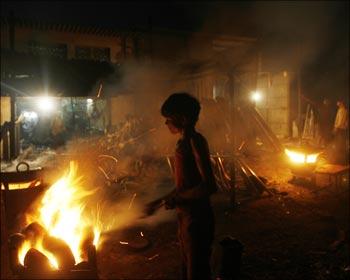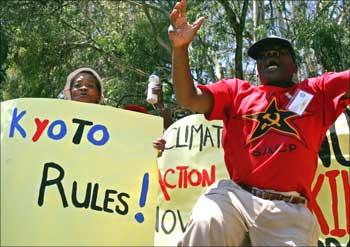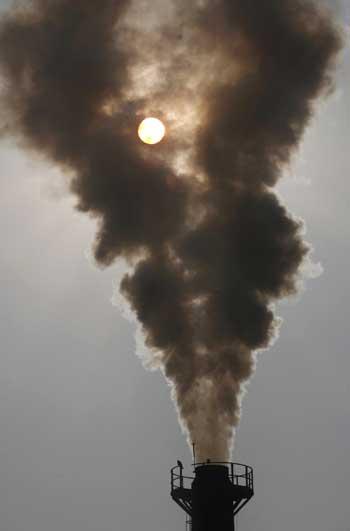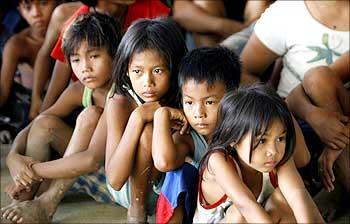
On December 7, officials from 192 countries are meeting in Copenhagen to tackle the terrifying challenges that all of us face due to climate change, and to seek a successor to the 1997 Kyoto Protocol.
Even if the leaders can't negotiate a binding agreement, many countries hope to work out commitments to reduce their greenhouse-gas emissions and provide assistance to poorer countries likely to be hardest hit by the effects of global warming.
One hundred-and-ninety-two countries have signed the climate change convention. More than 15,000 officials, advisers, diplomats, protestors and journalists are attending the meet, joined by heads of state.
Developing countries, including India and China, believe it is the responsibility of wealthy industrialised nations such as the United Kingdom and the United States to set a clear example on cutting carbon emissions.
Every country has its own views and agenda. To find out which country wants what at the Copenhagen Summit, read on. . .
Click NEXT button to proceed.

India
India is the world's number four greenhouse gas emitter. Prime Minister Manmohan Singh ended days of speculation by saying that he would attend the two-week climate change talks that began on Monday in Copenhagen, Denmark.
India announced recently that it would aim to slow the growth of its carbon dioxide emissions over the next decade and beyond -- signalling a softening of its hard-line stance on climate change negotiations.
Environment Minister Jairam Ramesh told Parliament recently that the country would reduce its 'carbon intensity' -- the amount of carbon dioxide emitted for each unit of gross domestic product -- by up to 25 per cent from 2005 to 2020.
The minister stated that this improvement would be made on a voluntary basis. He also made it clear that India would not agree to any legally binding emissions targets. Environmentalists welcomed the minister's statement; opposition politicans did not.
India's intensity of carbon dioxide or CO2 use is among the lowest in the world (and equal to that of Europe in 2007), and China's is among the highest.
India's trend decline in intensity is comparable to the world's average. However, the centre categorically states that in no way do these 'new' targets put pressure on India to commit to any reduction target. The current Indian per capita emission is 1.1 tonne. For the US, this figure is more than 20 tonnes.
India's energy intensity by unit of GDP has reduced from 0.3 kgoe (kilogramme of oil equivalent) per dollar GDP in PPP terms in 1980 to 0.16 kgoe currently. This is already lower than US and China and is comparable to Germany.
The Federation of Indian Chambers of Commerce and Industry, however, on December 7 expressed alarm over reports that India might shift its stance on the issue of climate change at the Copenhagen summit.
In an open letter to the prime minister and Union commerce minister Anand Sharma, the industry body has outlined its views on the climate change negotiations based on corporate India's feedback and called for the prime minister to urge the developed world to provide technology transfer and funds to help mitigate the crisis.

United States of America
The United States had rejected the 1997 Kyoto Protocol, with the then US President George W Bush arguing that the 5 per cent reductions required by Kyoto would 'wreck the American economy'.
However, Copenhagen sees a glimmer of hope on President Barack Obama's stated intention to achieve an 80 per cent reduction of greenhouse gas emissions by 2050. Some people have even named the event the 'Hopenhagen' Summit.
The US wants other countries, mainly China and India to commit on when their greenhouse-gas emissions will peak.
The country will also ask for strict standards for reporting, monitoring and verification of emissions and reductions.
The Centre for Science and Environment said that for the US, the emission cap translates into a mere 3 per cent reduction below the 1990 levels while science demands that developed countries cut their emissions by 40 per cent below 1990 levels.
Besides, the US targets remain domestic and are not covered by a multilateral legally-binding agreement.

China
Prior to Copenhagen Summit, China had sent out positive vibes that it is willing to reach an agreement. The country dreads the end of the Kyoto provisions.
For, China has been the top receiver of tradable credits, thanks to the Kyoto provisions, getting as much as 59 per cent.
The country is also optimistic of getting more funds and technology transfers from developed nations. The country being a leading exporter if solar-power and wind-power equipment, that could translate into an increased demand for its products.
China pledged to curb voluntarily carbon emissions as a percentage of gross domestic product by 40 to 45 per cent by 2020.The Centre for Science and Environment, however, states that China's emissions will continue to grow but at a slower rate. How much is actually achieved will depend on the rate at which the Chinese economy swells.
In other words, if the economy grows at 7 per cent per annum, then the emissions of China, after accounting for the 40-45 per cent energy intensity reduction target will grow by 50 per cent over 2005 levels.
If the economy grows at 10 per cent per annum, then the emissions will increase by 150 per cent over 2005 levels.

Brazil
Brazil seems keen to cut greenhouse gas emissions by reducing deforestation in the Amazon rain forest and by increasing the use of cars and trucks that run on biofuels.
The country intends to cut its carbon emission rate by up to 39 per cent, provided the government gets enough funds to meet its aggressive goals.
However, lawlessness in the poverty-stricken Amazon could provide obstacles to the country's bid to reduce deforestation.

European Union
Prior to the Copenhagen Summit, members of EU Parliament urged the European Union to continue leading fight against climate change.
The European Parliament's expectations for the Copenhagen Summit include an ambitious and legally binding agreement that will require emission reduction targets for developed and developing countries as well as funding commitments and sanctions for non-compliance.
The EU aims to cut CO2 emissions 20 per cent by 2020 from 1990 levels. It is also willing to raise that target to 30 per cent if other countries agree to do their part.

Poland
Poland and other Eastern European nations expect an affordable deal out of the Copenhagen Summit. As Poland has reduced CO2 emissions by 30 per cent over the past 20 years, it can sell credits worth billions of euros.
Poland also wants to continue selling carbon credits after the Kyoto protocol expires in 2012.
It needs to be seen how financial support for developing countries will be shared by EU members. As the EU's eastern members' energy sectors rely heavily on coal, they are likely to pay more.

Africa
African countries are of the opinion that greenhouse-gas emissions, record droughts in East Africa as well as flooding in other regions are the developed countries' doing. Hence, they seek to be compensated for the impact of global warming.
However, their priorities differ.
The African Union also wants billions of dollars to adapt to climate change.
Oil-producing nations, such as Nigeria, fear that they could lose revenues from expected declines in oil consumption and hence seek compensation.

Indonesia
Indonesia records much of the emissions resulting from deforestation. Indonesia is a very heavy CO2 emitter. Hence, the country is likely to ask for international technology and funds for forest conservation.
The nation pledges to cut emissions 26 per cent by 2020 from 'business-as-usual' levels.
The country hints that it will oppose efforts to create a global monitoring body. Indonesia will raise its target to 41 per cent if it receives adequate international support.

Ecuador
Ecuador is partcipating at the Copenhagen Summit with a unique idea: get rich countries to pay $3.5 billion to keep 850 million barrels of its crude in the ground. The oil is located in a natural reserve of the Amazonian forest.
Talks on how to protect this natural reserve are going to dominate the summit. An Organization of Petroleum Exporting Countries team has visited the reserve already.

Russia
Climate change doesn't rank high on Russia's agenda. The country's focus is on investments that it needs to make its industries more energy efficient.
According to diplomats, the country is willing to reduce emissions between 20 per cent and 25 per cent from 1990 levels.
Prime Minister Vladimir Putin says Russia will join a post-Kyoto agreement only if other countries sign up for it and if Russian forests' contribution to reducing global carbon dioxide is taken into account.